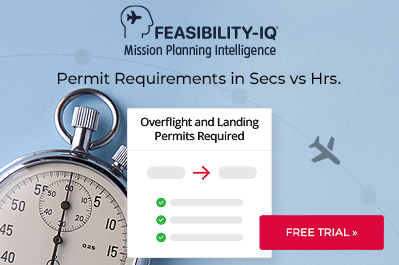Overflight Permits – Part 2: Documentation and Revisions

This business aviation blog post continues from our article last week, entitled: “Overflight Permits – Part 1: General Requirements.”
Overflight requirements around the world vary substantially. There can be unique – and sometimes strange – requirements for what constitutes an overflight, the documentation needed, lead times and validity periods, and communication procedures. Always double-check requirements in advance, provide sufficient lead time, and ensure that your 3rd-party provider is able to obtain the necessary permits and to arrange for payment.
The following is an overview of what you need to know:
1. Information/documentation requirements
While some countries require only standard aircraft and operator information, along with schedule and crew/passenger details, others require submission of additional documentation/information for overflight requests. Bolivia requires that permit requests be submitted on a specific form. Saudi Arabia mandates that requests be submitted with a specific template. Turkey requires a noise certificate to process any overflight request. Many countries are becoming more stringent, with more specific documentation requirements than in the past.
01/13/2015: Updated per reader
2. Some countries do not require documentation for overflight requests
Certain countries do not require submitted documentation for overflight approvals. Uzbekistan, for example, has no overflight permit-related documentation requirements, while neighboring Kyrgyz Republic needs to see all standard aircraft/crew documentation as well as a “passenger insurance license.”
01/13/2015: Updated per reader
3. Permit charges, validity, and revisions
There are charges for overflight permits, and each country determines its own permit validity window. Some Civil Aviation Authorities (CAAs) charge a flat fee for overflight permits, while others charge by the length of time in the airspace, or even based on the weight of the aircraft. They may also charge for short-notice turnaround time on permits, or other items that may be unique to that country. Some CAAs provide +/- 72 hours overflight permit validity while others only allow the approved flight plan time as given. For Russian permits if you arrive at the Flight Information Region (FIR) even 10 minutes early, a revision is needed. Always keep in mind that overflight permits must be revised if you’re outside the stated validity, and it’s important to be aware of permit revision procedures.
4. Consider communication preferences/procedures
It’s important to understand preferred communication methods when requesting permits. Most permits are requested via e-mail, but some CAAs may only be set up to receive small attachments. This may involve sending multiple e-mail messages. Some countries accept overflight requests either by e-mail or fax. Some countries, however, want permit requests to come in via AFTN or SITA. For Saudi Arabia overflight permits, you’ll need to use a special template that must be completed and forwarded via e-mail.
5. Additional non-standard documentation requirements
When overflying the Kyrgyz Republic, you’ll need to provide a “passenger insurance license” with any overflight request. India requests that you inform them if your aircraft has “air drop capabilities.” China wants to ensure you don’t have a “surveillance certificate.” A few countries require operators to provide notification of particular onboard equipment – such as TCAS II.
6. Unique permit requirements/issues
Countries that normally require overflight permits may have certain routings with no permit requirements. You don’t need a China overflight permit, for example, when operating within Sanya and Guangzhou FIRs. On the other hand, Senegal mandates overflight permits for a very large area over the Atlantic Ocean even though these are international waters. Be aware that there are countries in Africa that don’t have their own FIR, but overflight permits are still needed. In some cases you’ll encounter overflight permit requirements that mandate additional and specific documents. This documentation must be in order and valid to obtain desired permits.
7. Additional one-off permit issues
An overflight permit is needed when overflying Matak Island in Indonesia although this does not usually show up in the International Civil Aviation Organization portion of the flight plan. Nicaragua only mandates a permit if you’re overflying the landmass (along with a CENAMER notification). Likewise, India only requires an overflight permit if you are overflying the landmass. If your flight routing takes you over the Andaman Islands, however, you’ll be forced to divert if you do not have an Indian overflight permit.
When you are overflying San Andres Island (SKSP), located within the SPP FIR control area, you will also need a Columbian overflight permit even though you are nowhere near the Columbian landmass. If you don’t have a required overflight permit, your flight plan may be denied. Or, if your flight plan is accepted, you may find you need to divert around the airspace last-minute.
Final points
Attempting to process overflight permits on your own can be a challenge and is seldom recommended. This is due, in part, to language barriers and different required payment processes. Always be prepared for a Plan B permit scenario, due to a permit being denied or last-minute weather changes that may force a routing change.
Questions?
If you have any questions about this article, contact me at shawnleavell@univ-wea.com.




